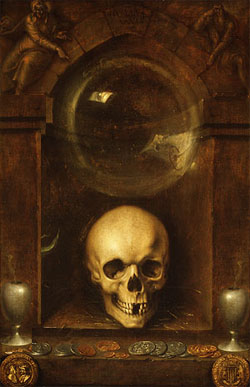Blood money exacts a terrible price upon those who carry it: If someone should die while in possession of blood money their soul will automatically be imprisoned within the coin as per the soul bind spell – preventing them from being returned to life via a clone, raise dead, reincarnation, resurrection, true resurrection, or even a miracle or wish. Only by destroying the coin or dispelling the magic upon it can one free the soul (which is still dead, but can now be returned to life normally).
Evil spellcasters have been known to trick adventurers by hiring them on legitimately worthy missions, and then giving blood money as a reward. The adventurers will subsequently be ambushed by their minions (with the goal of killing as many as possible and escaping with the blood money which now contains their soul) – thus keeping the spellcaster safe, while gaining them souls upon which to practice their foul arts.
Similar tricks have been used to ensure the near-permanent destruction of enemies or to extort ransoms from the rich and powerful (for example, by using blood money to entrap the soul of a merchant’s daughter).
Caster Level: 17th
Prerequisites: Craft Wondrous Item, soul bind
Market Price: 600,000 gp
THE GILTED FIEND
During the great bulk of the day, a gilted fiend will appear as a perfectly normal gold piece. At the stroke of midnight, however, the coin will transform into a small, golden creature with an impish tendency towards practical jokes, tricks, and surprises. This transformation will last for 1d6 x 10 minutes.
When the gilted fiend first appears it will have a friendly, if somewhat mischievous, effect. Its owner (or owners) might find their boots mended in the morning, for example – or perhaps awaken to find breakfast already cooked. As time passes, however, the gilted fiend’s behavior will slowly change until, finally, it will truly live up to its name. Instead of finding items repaired, its owners will find items broken or missing. They may awake in the morning to find their bodies riddled with strange injuries they didn’t have before falling asleep. Finally the gilted fiend will turn murderous – its owner usually turning up slain by their own weapon in an apparent suicide.
While in its transformed state, the gilted fiend will do its best to avoid detection. If it is detected, it will still attempt to disguise its nature by doing everything possible to prevent people from seeing the actual moment of transformation.
If it becomes important, the gilted fiend can be considered to possess the same stats as an imp during its period of transformation (see pg. 48 of the MM). While in coin form, it will be indistinguishable from a normal coin (except through the use of spells such as detect magic) and can be destroyed through perfectly normal means (by melting it down, for example). Any damage done to the gilted fiend while in its transformed state will have automatically healed by the next night.
Caster Level: 15th
Prerequisites: Craft Wondrous Item, polymorph any object
Market Price: 250,000 gp












